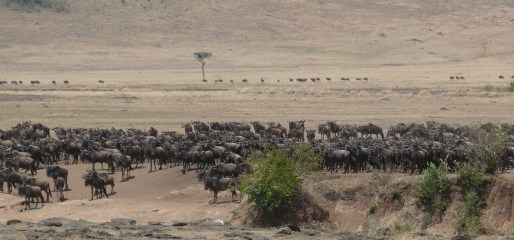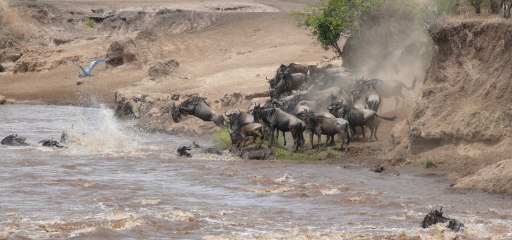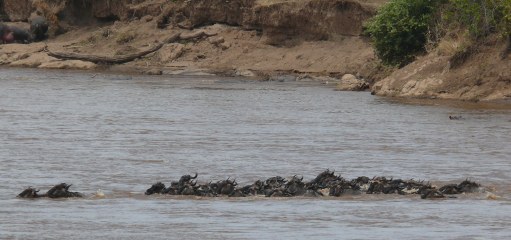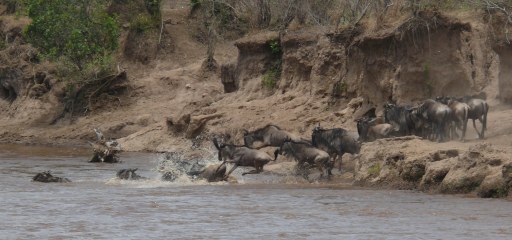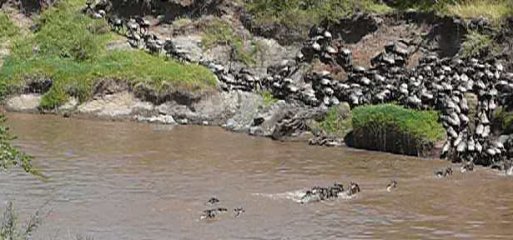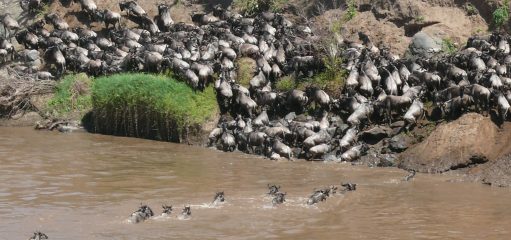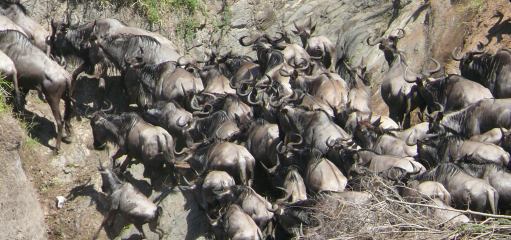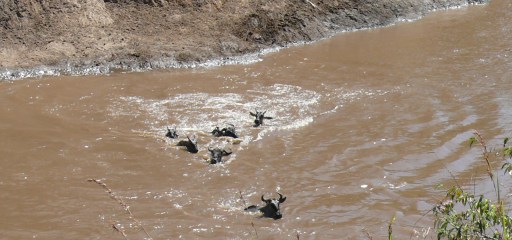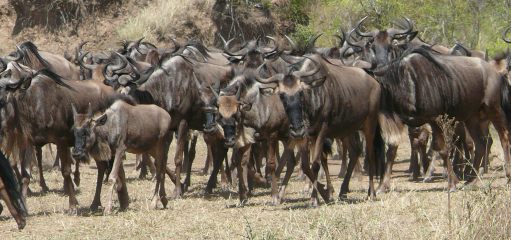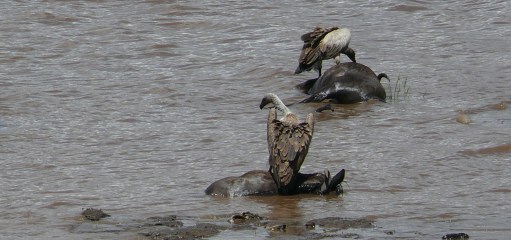Wildebeest Migration
The Great Migration of millions of Wildebeest in Eastern Africa is one of the last remaining giant animal trekks in the world. It's like a miracle: without
doing the permanent circle between Ngorongoro and Serengeti in Tanzania and Maasai Mara in Kenya these large herds of grazing animals could never exist in one
place. Only by following their instinct to trekk they will always be able to find enough fresh grass to feed.
And it's not only Wildebeest (between 1,5 and 2,5 millions), there are also huge numbers of Zebra (around half a million) and Gazelles on the way, not to
speak of the lions, hyenas, jackals and other carnivores who follow the herbivores.
If we look at the circle from a yearly perspective, the peiod from Januray to March finds the grazing animals in the southeastern planes of Serengeti and the
Ngorongoro Conservation Area, feeding on juicy short grass. In February around half a million of Wildebeest calfs are born, a feast for the predators, but due to the
fact that so many calfs are born at once, nature ensures the survival of enough young Wildebeest.
With the beginning of the rainy season end of March the herbivores trekk slowly to the western and northwesten areas of Serengeti, from Naabi Hills to Grumeti
River. In June they're mostly in the so called Western Corridor and will cross Grumeti River which is challenging them a lot because of the many Crocodiles demanding
their share of the overflowing supply of food crossing the water.
In July and August they trekk further to the north, passing the Lobo and Ikorongo areas, heading for Kenya's Maasai Mara. There they have to face the maybe
greatest challenge of the whole migration cycle: they have to cross the Mara River which is swollen with water at that time. Many Wildebeest and Zebra loose their
life there, either direclty to crocodiles waiting for them in the water or due to injuries like broken limbs they get within the huge, pressing mass of animals which
may shove them down the steep riverbanks or onto rocks.
During August, September and October Kenyas Maasai Mara boosts of grazing animals. The Mara and Talek river ensure that grass is plenty in Mara while the Serengeti
faces the drieest months of the year. And it's not only herbivores that can be found in huge numbers. Also Lion, Cheetah, Leopard, Hyena and other predators have the
best time of their year due to an overwhelming supply of Antelopes, Gazelles, Wildebeest and Zebra to hunt.
End of October / early November the migrating animals start to go back south, again facing the challenge of crossing the Mara River with it's steep riverbanks
and the waiting crocodiles. Back in Tanzania, during December they head straight down to the southeastern parts of Serengeti and Ngorongoro Conservation Area.
This magic migration circle happens every year, not exactly following the monthly structure because of different weather conditions will slow down or hurry up
the speed of the trekking animals. Nature makes sure that the number of animals killed on the trekk is small enough not to weaken the whole migrating mass. There is
a fine balance which also ensures the survival of the many predators like lions, crocodiles and of course also the vultures. Nothing is wasted, all stays within the
permanent circle of life, death is only a station on this circle and ensures the life of another animal. In years of drought, of course, more animals die and the
migrating numbers are not that big. But with enough supply of grass and water in other years, the numbers of migrating animals increase again.
Although the months of July to October are the time when Maasai Mara boosts of animals, it's not empty in the rest of the year. Big herds of Antelopes,
Gazelles and Zebra live permanently in Maasai Mara and with them many prides of Lions, hunting Leopards, small familiy groups of Cheetah and other predators.
|
